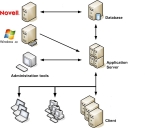About Application Control and Device Control Architecture
Ivanti Device and Application Control architecture is a multi-tier system composed of a database, an Application Server, and a client.
The three primary components that form the basis of Ivanti Device and Application Control system architecture interact as follows. The Application Server component runs as a service that:
- Keeps track of the connected clients and their status.
- Coordinates data flow between the Application Server(s) and the SQL database.
The database component serves as the central repository of the authorization and permission policies. The client component stores file authorization and device permission policies locally, and controls user access from the endpoint to software applications and all connected devices. To change authorization and permission policies, an administrator uses a Management Console to interface with the Application Server(s), which then communicate with the database and the client(s).
Ivanti Device and Application Control system architecture is scalable to meet the needs of any enterprise. You can use multiple Application Server(s) and clients.
The Application Control and Device Control architecture components are:
- The database which serves as the central repository of authorization information for devices and applications.
- One or more Application Servers that communicate between the database, the protected clients, and the Management Console.
- The client (installed on each computer, endpoint or server that you want to protect).
- The Management Console, which provides the administrative user interface for the Application Server.
The following figure illustrates the relationships between the components.
